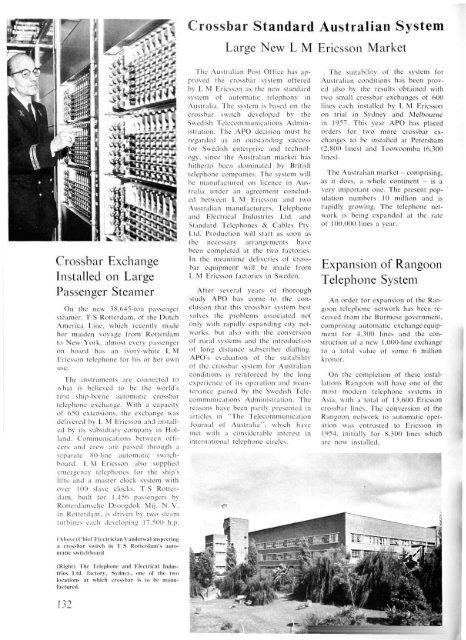1959 - History of Ericsson - History of Ericsson
1959 - History of Ericsson - History of Ericsson
1959 - History of Ericsson - History of Ericsson
You also want an ePaper? Increase the reach of your titles
YUMPU automatically turns print PDFs into web optimized ePapers that Google loves.
Crossbar Exchange<br />
Installed on Large<br />
Passenger Steamer<br />
On the new 38,645-ton passenger<br />
steamer, T/S Rotterdam, <strong>of</strong> the Dutch<br />
America Line, which recently made<br />
her maiden voyage from Rotterdam<br />
to New York, almost every passenger<br />
on board has an ivory-white L M<br />
<strong>Ericsson</strong> telephone for his or her own<br />
use.<br />
The instruments are connected to<br />
what is believed to be the world's<br />
first ship-borne automatic crossbar<br />
telephone exchange. With a capacity<br />
<strong>of</strong> 650 extensions, the exchange was<br />
delivered by L M <strong>Ericsson</strong> and installed<br />
by its subsidiary company in Holland.<br />
Communications between <strong>of</strong>ficers<br />
and crew are passed through a<br />
separate 80-line automatic switchboard.<br />
L M <strong>Ericsson</strong> also supplied<br />
emergency telephones for the ship's<br />
lifts and a master clock system with<br />
over 100 slave clocks. T/S Rotterdam,<br />
built for 1,456 passengers by<br />
Rotterdamsche Droogdok Mij. N. V.<br />
in Rotterdam, is driven by two steam<br />
turbines each developing 17.500 h.p.<br />
(Above) Chief Electrician Yanderwal inspecting<br />
a crossbar switch in T S Rotterdam's automatic<br />
switchboard<br />
(Right) The Telephone and Electrical Industries<br />
Ltd. factory, Sydney, one <strong>of</strong> the two<br />
locations at which crossbar is to be manufactured.<br />
132<br />
Crossbar Standard Australian System<br />
Large New L M <strong>Ericsson</strong> Market<br />
The Australian Post Office has approved<br />
the crossbar system <strong>of</strong>fered<br />
by L M <strong>Ericsson</strong> as the new standard<br />
system <strong>of</strong> automatic telephony in<br />
Australia. The system is based on the<br />
crossbar switch developed by the<br />
Swedish Telecommunications Administration.<br />
The APO decision must be<br />
regarded as an outstanding success<br />
for Swedish enterprise and technology,<br />
since the Australian market has<br />
hitherto been dominated by British<br />
telephone companies. The system will<br />
be manufactured on licence in Australia<br />
under an agreement concluded<br />
between L M <strong>Ericsson</strong> and two<br />
Australian manufacturers, Telephone<br />
and Electrical Industries Ltd. and<br />
Standard Telephones & Cables Pty.<br />
Ltd. Production will start as soon as<br />
the necessary arrangements have<br />
been completed at the two factories.<br />
In the meantime deliveries <strong>of</strong> crossbar<br />
equipment will be made from<br />
L M <strong>Ericsson</strong> factories in Sweden.<br />
After several years <strong>of</strong> thorough<br />
study APO has come to the conclusion<br />
that this crossbar system best<br />
solves the problems associated not<br />
only with rapidly expanding city networks,<br />
but also with the conversion<br />
<strong>of</strong> rural systems and the introduction<br />
<strong>of</strong> long distance subscriber dialling.<br />
APO's evaluation <strong>of</strong> the suitability<br />
<strong>of</strong> the crossbar system for Australian<br />
conditions is reinforced by the long<br />
experience <strong>of</strong> its operation and maintenance<br />
gained by the Swedish Telecommunications<br />
Administration. The<br />
reasons have been partly presented in<br />
articles in "The Telecommunication<br />
Journal <strong>of</strong> Australia", which have<br />
met with a considerable interest in<br />
international telephone circles.<br />
The suitability <strong>of</strong> the system for<br />
Australian conditions has been proved<br />
also by the results obtained with<br />
two small crossbar exchanges <strong>of</strong> 600<br />
lines each installed by L M <strong>Ericsson</strong><br />
on trial in Sydney and Melbourne<br />
in 1957. This year APO has placed<br />
orders for two more crossbar exchanges<br />
to be installed at Petersham<br />
(2,800 lines) and Toowoomba (6,300<br />
lines).<br />
The Australian market - comprising,<br />
as it does, a whole continent - is a<br />
very important one. The present population<br />
numbers 10 million and is<br />
rapidly growing. The telephone network<br />
is being expanded at the rate<br />
<strong>of</strong> 100,000 lines a year.<br />
Expansion <strong>of</strong> Rangoon<br />
Telephone System<br />
An order for expansion <strong>of</strong> the Rangoon<br />
telephone network has been received<br />
from the Burmese government,<br />
comprising automatic exchange equipment<br />
for 4,300 lines and the construction<br />
<strong>of</strong> a new 1,000-line exchange<br />
to a total value <strong>of</strong> some 6 million<br />
kronor.<br />
On the completion <strong>of</strong> these installations<br />
Rangoon will have one <strong>of</strong> the<br />
most modern telephone systems in<br />
Asia, with a total <strong>of</strong> 13,600 <strong>Ericsson</strong><br />
crossbar lines. The conversion <strong>of</strong> the<br />
Rangoon network to automatic operation<br />
was entrusted to <strong>Ericsson</strong> in<br />
1954, initially for 8,300 lines which<br />
are now installed.
















